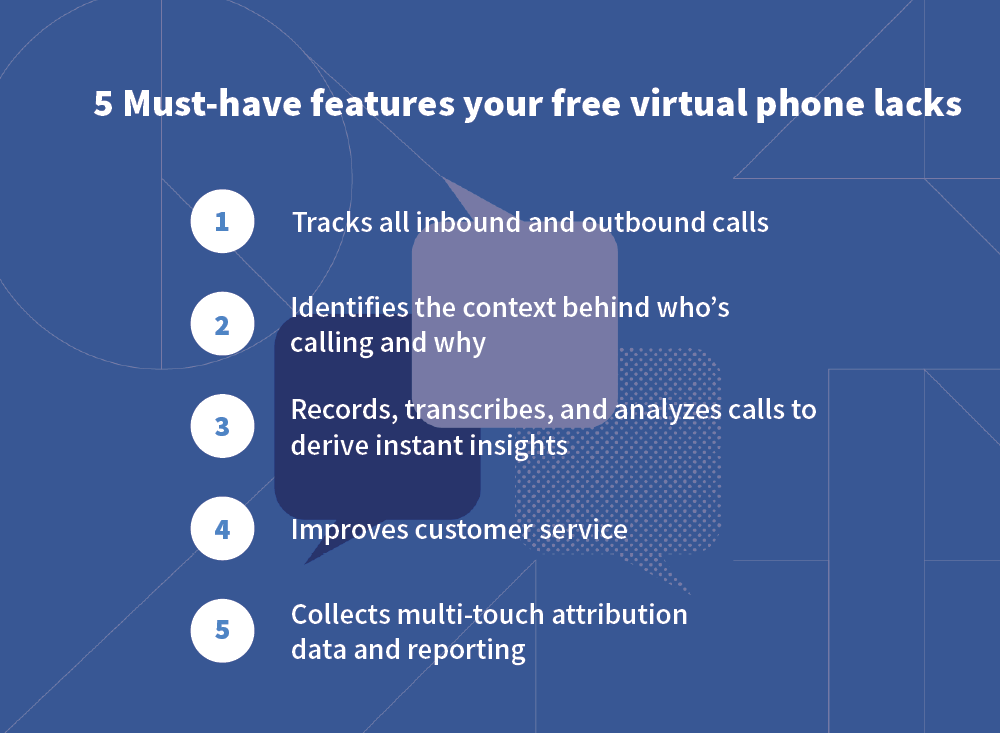Businesses are always looking for ways they can successfully acquire new customers and retain existing ones. Surprisingly, however, there’s one area where businesses consistently miss out on a significant amount of value: their phone calls. This is especially true for businesses that use free virtual phones.
2020 saw call volumes go through the roof — and it’s likely that this will continue going forward. Lockdowns and quarantines mean that customers have now by and large become used to ringing up businesses whenever they have a query, instead of simply strolling along to your store.
If you have the right call strategy in place, this increased call volume is great news. Calls provide your business with a treasure trove of information — helping you better understand your customers’ intent and what made them call in the first place. Once you gain these insights, you can then invest in marketing strategies that you know are proven to work — instead of simply hoping for the best.
This means you need to derive as much value as possible from your call strategy — but you can’t do this with a free virtual phone. While it may be free, it’s not contributing anything to helping you grow your business. You don’t gain any context behind who’s calling and why. What’s more, you’re unable to analyze call transcripts, making it almost impossible to improve your communication tactics going forward.
The most successful businesses out there derive value from calls long after the caller has put the phone down. With a free virtual phone, however, you’re only able to benefit the bare minimum that calling has to offer your business: letting you speak to potential customers at the end of the line.
Let’s examine why your free virtual phone is actually damaging your business’s bottom lines before exploring better alternatives that’ll bring more value to your business.
The must-have features your free virtual phone lacks
You might be reading this and thinking: “Sure, I know my phone is pretty basic, but it does what I need it to do — it allows me to make and receive calls.” Great. But this is the absolute bare minimum for any phone. You don’t gain any more value than simply being able to speak to someone at the other end of the line.
Being able to speak to your customers is just the first piece of the puzzle. Businesses need to ensure that they’re also able to:
- Track all inbound calls and work out what marketing efforts made people pick up the phone
- Identify the context behind who’s calling and why
- Record and analyze transcripts to derive instant insights
- Improve their customer service
- Cross-reference call data and report with ease
If your call strategy allows you to achieve all these four points, you’ll bolster your sales, increase your revenue, transform your customer satisfaction, and fine-tune your marketing strategy going forward.
This is where your free virtual phone comes up short — and why investing in a platform like CallRail can help you unlock the insights behind your conversations, generating new business, and driving ROI. Let’s analyze how CallRail’s all-encompassing platform gives you everything you need to make the most out of your calls.
Track all inbound calls and work out which marketing materials made people pick up the phone
An estimated 85% of callers never ring a company back if their call is missed, which is why it’s so important that you meticulously track all your business’s calls. That’s where call tracking comes in.
Generally speaking, call tracking is the process of determining how callers found you and which marketing strategies propelled them to ring up your business. It assigns each of your marketing tactics its own tracking number, with dynamic number insertions (DNIs ensuring that every inbound caller will also receive their own unique tracking number.
When a visitor dials this number, our call tracking capabilities tie their session data to that unique phone number. Even if they lapse and then return to your site a couple of weeks later, they’ll still see this number thanks to cookies (which enable us to use cross-device, cross-platform, multi-touch attribution). This means that when a customer calls, you’ll be able to identify who it is and what marketing brought them to your business — meaning you can pour more investment into these successful strategies going forward.
Plus, calls can sometimes get lost in the sauce — especially if you work in a small business where it’s all hands on deck. While Google Ads and Google Analytics are great at identifying online conversions and goal completions, they aren’t able to track call data. For example, you might have produced a whitepaper that ends with a specific call-to-action (CTA) encouraging readers to pick up the phone to find out more.
If you never end up tracking your inbound calls, however, and only look at online conversions/goal completions, then you may end up thinking that the whitepaper had little impact on your business — even if it led to hundreds of inbound calls.
By appropriately tracking your calls, using a multi-touch attribution call tracking system that matches your calls to specific marketing efforts, you’ll quickly recognize which strategies are working and which aren’t. With visitor-level call tracking, you can see precisely where each caller found you, and even track which PPC keywords are most effective.
CallRail's Call Tracking offers up a wide variety of data, including:
- The caller’s name, telephone number, and location
- The source of the call (this is manually set by the marketer, so would appear as ‘Google Ads’ or ‘Spring 2020’, for example)
- The caller’s timeline: previous calls and texts from this number, tags categorizing each interaction, and specific notes from previous interactions
- Visitor session data: referrer, landing page, pages visited, active page during the call, and the device and browser the caller used
Armed with these insights, you’ll be in a position to start putting calls front and centre of your marketing strategy.
Identify the context behind who’s calling and why
There are more ways than ever to attract leads to your company. But prospects today expect more in return from companies — so you need a way to appropriately manage all your calls in one single place.
That’s where CallRail's Lead Center comes in, it's a complete communications hub where you can manage all incoming texts, calls,emails, and chat (coming soon) in a single inbox. Staying on top of your calls, texts, emails, and forms used to be a time-consuming and incredibly confusing process. Fortunately, that no longer has to be the case.
Lead Center automatically captures all lead data before saving it in one single place, meaning you’ll never again lose a potential lead. Missed a call? Don’t worry — simply ring them back with one click.
Plus, Lead Center also gives you context behind every lead, providing a complete timeline of all their previous interactions with your company. More generally, it will help you:
- Stay on top of all inbound communications, automatically capturing lead data
- Save a considerable amount of time and effort chasing up leads
- Understand the context behind every call
- Respond to prospects quicker than ever before
This is especially important right now. With so many of us working remotely, it’s easy for leads to slip through the cracks. Fortunately, Lead Center is built around a VoIP system. Call agents can handle all communications from their desktop, laptop, or mobile, via the Lead Center app for both iOS and Android.
As a result, agents can appropriately manage their loads with ease — no matter where they’re located. It also means that agents can use their own phones to handle calls without divulging their personal number.
And when you do manage to speak to the lead (which only takes one click), you’ll know exactly where they’ve come from, when they’ve interacted with your company in the past, and you’ll see any relevant notes and tags on what they’re looking for. During your chat, you can also apply any relevant tags or notes thanks to our easy-to-use classification panel.
Record and analyze transcripts to derive instant insights
As useful as call tracking is on its own, its insights are made even richer and more valuable thanks to the addition of CallRail's Conversation Intelligence. It’s all well and good identifying who’s calling and where they came from — but the most important insights are hidden within the call itself. However, the process of manually poring over transcripts to identify these insights is overly error-prone and time-consuming.
Conversation Intelligence leverages the power of artificial intelligence (AI) to analyze all your calls quicker, easier, and more accurately than ever before. It powers Conversation Intelligence’s latest feature, Automation Rules, where you can use a wide variety of out-of-the-box templates to identify valuable keywords in an instant. Our intuitive, centralized dashboard will then collect all relevant information before presenting it in an easy-to-understand manner (using word clouds and bar graphs, among other formats).
Move away from finding needles in haystacks. Instead, instantly view all relevant keywords and phrases in word clouds or bar graphs. This will also help you improve your marketing efforts, showing which keywords in particular crop up again and again — and potentially highlighting new keywords that you should consider bidding on. In fact, some customers have reported that Call Intelligence alone helped them save a massive 90% of the time they previously spent on manually analyzing calls.
Improve customer service
Once you’ve recorded and analyzed your calls, you then need to feed these critical insights back into your communications training: improving how you deal with callers and transforming your customer service in the process. Fortunately, this can now be entirely automated.
With the Call Analytics dashboard, you have an easy-to-use, centralized dashboard to help you with Call Scheduling, Keypad Scoring, and CallRail Agent, where you can assign a specific agent to speak to certain callers each time they ring.
With one out of three customers reporting that they’d stop doing business with a brand they love off the back of just one poor experience, customer experience is what will set you apart from the rest. Ditch your free virtual phone to begin turning your customer service into a genuine competitive advantage.
Cross-reference call data and report with ease
Phone calls are far from the be-all and end-all of your inbound communications. Did you know that a reported 74% of companies use forms for lead generation, and 49.7% have even declared that forms are their number one lead generation tool?
With a free virtual phone, however, you get no insight into how your forms have performed — and no way to cross-reference this information with your call data. CallRail's Form Tracking, on the other hand, is the perfect accompaniment to Call Tracking. It essentially works in the same manner, installing a single line of Javascript code onto your site that captures information on every lead that fills out a form before relaying this back to the CallRail hub.
Imagine a prospect clicks on an ad for your new range of SUVs. They click through onto a landing page where they’re encouraged to download a report outlining the different SUVs: their capabilities, price, customization options, and more. After reading the report, they ring your number to find out more from a call agent.
Form Tracking seamlessly connects all these touchpoints, providing a clear timeline of the prospect’s activity to date that’s available to view from the very first moment that you pick up their call.
What’s more, you can use Form Tracking to build custom forms, integrate existing forms, and pair all form-related data to inbound call conversions for a more holistic view of your inbound marketing efforts.
Forms aren’t going away anytime soon — and they should be at the heart of every business’s lead generation. By pairing this data with in-depth analytics, you’ll be able to clearly identify which marketing activities, keywords, sources, and campaigns are responsible for driving qualified, high-value leads to your business.
But once you’ve cross-referenced this data, you then need to set about reporting. After all, reporting is at the heart of analysis. To Improve what you do in the future, you must first look to the past to see what has been working, and why.
Good thing CallRail’s Call Tracking capabilities allow you to integrate data from a wide variety of sources — inbound calls, Google Analytics and Ads, Hubspot, and Salesforce, among others — before pulling them all together for the purposes of reporting. Never again struggle to integrate online and offline data. Instead, instantly view a comprehensive, cross-channel report that highlights which of your strategies have performed the best.
Call time on your ineffective call strategy
If you’re like most businesses, you’ll want to:
- Increase the number of inbound calls and forms that you receive
- Easily identify the context behind every caller
- Seamlessly manage all leads in one place
- Make customer service a competitive advantage
- Cross-reference all marketing data and report with ease
- Fine-tune your marketing strategy to increase the ROI of your efforts
So why are you still using a free virtual phone? It offers the bare minimum — the ability to speak to somebody on the end of the line — but provides no additional value. If you want to make the most out of your call strategy and improve your business’s fortunes going forward, then you should look no further than CallRail’s all-encompassing platform.
Transform your business’s fortunes today. Book a demo to learn how the CallRail platform helps you make the most out of calls.









